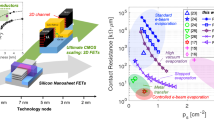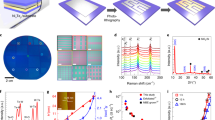Abstract
Two-dimensional semiconductors have a number of valuable properties that could be used to create novel electronic devices. However, creating 2D devices with good contacts and stable performance has proved challenging. Here we show that transferred via contacts, made from metal embedded in insulating hexagonal boron nitride and dry transferred onto 2D semiconductors, can be used to create high-quality 2D transistors. The approach prevents damage induced by direct metallization and allows full glovebox processing, providing a clean, stable and damage-free platform for 2D device fabrication. Using the approach, we create field-effect transistors (FETs) from bilayer p-type tungsten diselenide (WSe2) that exhibit high hole mobility and low contact resistance. The fabricated devices also exhibit high current and stability for over two months of measurements. Furthermore, the low contact resistance and clean channel allow us to create a nearly ideal top-gated p-FET with a subthreshold swing of 64 mV per decade at 290 K.
This is a preview of subscription content, access via your institution
Access options
Access Nature and 54 other Nature Portfolio journals
Get Nature+, our best-value online-access subscription
$29.99 / 30 days
cancel any time
Subscribe to this journal
Receive 12 digital issues and online access to articles
$119.00 per year
only $9.92 per issue
Buy this article
- Purchase on Springer Link
- Instant access to full article PDF
Prices may be subject to local taxes which are calculated during checkout






Similar content being viewed by others
Data availability
The data that support the findings within this paper are available from the corresponding authors on reasonable request.
References
Allain, A., Kang, J., Banerjee, K. & Kis, A. Electrical contacts to two-dimensional semiconductors. Nat. Mater. 14, 1195–1205 (2015).
Kerelsky, A. et al. Absence of a band gap at the interface of a metal and highly doped monolayer MoS2. Nano Lett. 17, 5962–5968 (2017).
English, C. D., Shine, G., Dorgan, V. E., Saraswat, K. C. & Pop, E. Improved contacts to MoS2 transistors by ultra-high vacuum metal deposition. Nano Lett. 16, 3824–3830 (2016).
Xu, S. et al. Universal low-temperature ohmic contacts for quantum transport in transition metal dichalcogenides. 2D Mater. 3, 021007 (2016).
Yamamoto, M., Nakaharai, S., Ueno, K. & Tsukagoshi, K. Self-limiting oxides on WSe2 as controlled surface acceptors and low-resistance hole contacts. Nano Lett. 16, 2720–2727 (2016).
Kim, D. et al. The enhanced low resistance contacts and boosted mobility in two-dimensional p-type WSe2 transistors through Ar+ ion-beam generated surface defects. AIP Adv. 6, 105307 (2016).
Chuang, H.-J. et al. Low-resistance 2D/2D ohmic contacts: a universal approach to high-performance WSe2, MoS2 and MoSe2 transistors. Nano Lett. 16, 1896–1902 (2016).
Kaushik, N., Karmakar, D., Nipane, A., Karande, S. & Lodha, S. Interfacial n-doping using an ultrathin TiO2 layer for contact resistance reduction in MoS2. ACS Appl. Mater. Interfaces 8, 256–263 (2016).
Kim, C. et al. Fermi level pinning at electrical metal contacts of monolayer molybdenum dichalcogenides. ACS Nano 11, 1588–1596 (2017).
Kaushik, N. et al. Schottky barrier heights for Au and Pd contacts to MoS2. Appl. Phys. Lett. 105, 113505 (2014).
Lee, G.-H. et al. Highly stable, dual-gated MoS2 transistors encapsulated by hexagonal boron nitride with gate-controllable contact, resistance and threshold voltage. ACS Nano 9, 7019–7026 (2015).
Movva, H. C. P. et al. Density-dependent quantum Hall states and Zeeman splitting in monolayer and bilayer WSe2. Phys. Rev. Lett. 118, 247701 (2017).
Wang, G. et al. Exciton dynamics in WSe2 bilayers. Appl. Phys. Lett. 105, 182105 (2014).
Jones, A. M. et al. Spin-layer locking effects in optical orientation of exciton spin in bilayer WSe2. Nat. Phys. 10, 130–134 (2014).
Lee, J.-H. et al. Reliable piezoelectricity in bilayer WSe2 for piezoelectric nanogenerators. Adv. Mater. 29, 1606667 (2017).
Liu, Y. et al. Approaching the Schottky–Mott limit in van der Waals metal–semiconductor junctions. Nature 557, 696–700 (2018).
Telford, E. J. et al. Via method for lithography free contact and preservation of 2D materials. Nano Lett. 18, 1416–1420 (2018).
Wang, Y. et al. Does p-type ohmic contact exist in WSe2–metal interfaces? Nanoscale 8, 1179–1191 (2015).
Choi, H. H. et al. Accurate extraction of charge carrier mobility in 4-probe field-effect transistors. Adv. Funct. Mater. 28, 1707105 (2018).
Allain, A. & Kis, A. Electron and hole mobilities in single-layer WSe2. ACS Nano 8, 7180–7185 (2014).
Movva, H. C. P. et al. High-mobility holes in dual-gated WSe2 field-effect transistors. ACS Nano 9, 10402–10410 (2015).
Zhang, R., Drysdale, D., Koutsos, V. & Cheung, R. Controlled layer thinning and p-type doping of WSe2 by vapor XeF2. Adv. Funct. Mater. 27, 1702455 (2017).
Chen, C.-H. et al. Hole mobility enhancement and p-doping in monolayer WSe2 by gold decoration. 2D Mater. 1, 034001 (2014).
Fang, H. et al. High-performance single layered WSe2 p-FETs with chemically doped contacts. Nano Lett. 12, 3788–3792 (2012).
Shokouh, S. H. H. et al. High-performance, air-stable, top-gate, p-channel WSe2 field-effect transistor with fluoropolymer buffer layer. Adv. Funct. Mater. 25, 7208–7214 (2015).
Chuang, H.-J. et al. High mobility WSe2 p- and n-type field-effect transistors contacted by highly doped graphene for low-resistance contacts. Nano Lett. 14, 3594–3601 (2014).
Tosun, M. et al. High-gain inverters based on WSe2 complementary field-effect transistors. ACS Nano 8, 4948–4953 (2014).
Appenzeller, J., Lin, Y.-M., Knoch, J. & Avouris, P. Band-to-band tunneling in carbon nanotube field-effect transistors. Phys. Rev. Lett. 93, 196805 (2004).
Yoon, Y. & Salahuddin, S. Inverse temperature dependence of subthreshold slope in graphene nanoribbon tunneling transistors. Appl. Phys. Lett. 96, 013510 (2010).
Nipane, A., Jayanti, S., Borah, A. & Teherani, J. T. Electrostatics of lateral p–n junctions in atomically thin materials. J. Appl. Phys. 122, 194501 (2017).
Ma, N. & Jena, D. Charge scattering and mobility in atomically thin semiconductors. Phys. Rev. X 4, 011043 (2014).
Acknowledgements
This work was supported by the National Science Foundation through a CAREER Award (ECCS-1752401) and by the Center for Precision Assembly of Superstratic and Superatomic Solids (DMR-1420634). This work is also supported by the National Research Foundation of Korea through the Global Research Laboratory (GRL) program (2016K1A1A2912707) and Research Fellow program (2018R1A6A3A11045864).
Author information
Authors and Affiliations
Contributions
Y.J., M.S.C., J.H. and J.T.T. conceived the research and designed the experiments. Y.J. and M.S.C. fabricated and measured the devices under J.T.T.’s supervision. A.N. and A.B. contributed to the data analysis and manuscript revision. B.K. contributed to the Hall measurements. A.Z. performed TEM measurements. T.T. and K.W. contributed h-BN material. W.J.Y., J.H. and J.T.T. contributed to discussions of the results. Y.J., M.S.C. and J.T.T. wrote the manuscript.
Corresponding author
Ethics declarations
Competing interests
The authors declare no competing interests.
Additional information
Publisher’s note: Springer Nature remains neutral with regard to jurisdictional claims in published maps and institutional affiliations.
Supplementary information
Supplementary Information
Supplementary Figs. 1–11.
Rights and permissions
About this article
Cite this article
Jung, Y., Choi, M.S., Nipane, A. et al. Transferred via contacts as a platform for ideal two-dimensional transistors. Nat Electron 2, 187–194 (2019). https://doi.org/10.1038/s41928-019-0245-y
Received:
Accepted:
Published:
Issue Date:
DOI: https://doi.org/10.1038/s41928-019-0245-y
This article is cited by
-
A detachable interface for stable low-voltage stretchable transistor arrays and high-resolution X-ray imaging
Nature Communications (2024)
-
Van der Waals enabled formation and integration of ultrathin high-κ dielectrics on 2D semiconductors
npj 2D Materials and Applications (2024)
-
Photogating-assisted tunneling boosts the responsivity and speed of heterogeneous WSe2/Ta2NiSe5 photodetectors
Nature Communications (2024)
-
Strain-restricted transfer of ferromagnetic electrodes for constructing reproducibly superior-quality spintronic devices
Nature Communications (2024)
-
Optimizing 2D-metal contact in layered Tin-selenide via native oxide modulation
Nano Research (2024)



